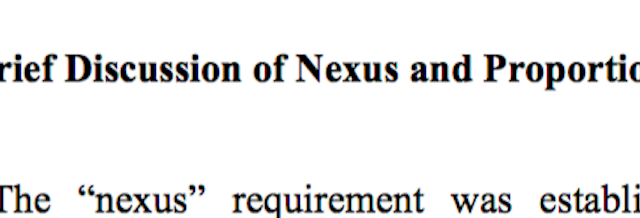Abutting Lot Decision: What Could it Mean for MIZ?
In yesterday’s post I gave a simple explanation of what I think, as a lay person, Judge Barbara Mack’s Decision meant. Today I’m going to speculate about how a challenge of Mandatory Inclusionary Zoning (MIZ) based on RCW 82.02.020, the plain language of which formed the basis of Judge Mack’s decision, might play out. There are many factors to consider when looking at potential litigation; we just won’t know until an actual case is filed and litigated. However, MIZ is putting the City between a rock and a hard place legally. In the end, whether MIZ survives a challenge under state law will depend on whether they pursue implementation based on a fair exchange of value–a trade of more building capacity for fees or inclusion–or whether they pursue a penalty model that attempts to use MIZ as a way to pay for impacts.
Let’s just look at the fee in lieu portion of the Mandatory Housing Affordability Framework passed by the City Council last month. Now, we have no idea about how much the City is going to charge because they still haven’t figured that out. But what we do know through various discussions is that they have a choice, a fair exchange of value or a fee to offset impacts. A value exchange would look like this:
The City grants an additional X percentage of square feet to a development in exchange for $Y per square foot of the gross square footage of the project receiving the grant.
In other words, the City gives value, the ability to make more money by building more rentable space in a project, quantifies that value in dollars or potential dollars, then charges the developer some portion or all of that dollar value. This kind of transaction would be essentially fiscal policy, creating money out of thin air by increasing the potential value of a site then capturing that value for public benefits.
But is that what the City is doing? Here’s what they passed:
23.58C.040 Affordable housing – Payment option
A. Payment amount
An applicant complying with this Chapter 23.58C through the payment option shall provide a cash contribution to the City, calculated by multiplying the payment amount per square foot according to Table A or Table B for 23.58C.040 and Map A for 23.58C.050, as applicable, by the total gross floor area in the development, excluding the floor area of parking located in stories or portions of stories that are underground.
Enshrined now in the code, without any numbers, is the mechanism to collect a fee. But what is the fee going to be based on. We still can’t really tell based on the letter of the code language passed. But we do know what the set up is based on the Determination of Non-Significance (DNS) promulgated by the City for the old linkage tax that didn’t go forward. It’s this DNS that has functioned for the MHA – R Framework. Here’s what the City says the program, now a MIZ mechanism not a linkage tax, is supposed to do (emphasis mine):
The proposed affordable housing mitigation program would require developers to provide affordable housing (either through performance or payment of a fee) regardless of whether an incentive was used, in order to mitigate (to some extent) the impacts of new development on the need for affordable housing.
Now before I go on about what this means technically, let me quote what Mayor Murray said about MHA at a public meeting in February. I think he’s articulating the common and plain language intent of MIZ through the MHA program (emphasis is mine):
The heart of HALA is you don’t get to develop housing in this city, multifamily housing, unless you build affordable housing as part of it. That is the key piece to it. We have developed . . . Wait, wait, wait. . . We have grown as a city, but we have not grown affordably. What we are saying is, if you are going to build a multifamily unit in an urban village, you are going to build affordable housing, or you are going to pay penalties that will go into a fund for building affordable housing.
So, the City doesn’t appear to be pursuing a value exchange model at all with MHA but rather an exaction model just like they said they would with the linkage tax described in their DNS for that proposal which now covers MHA. The City cites the nexus study (which has disappeared from the City’s website. Hmmmm. Here’s the memo.) commissioned a few years ago in the DNS, a study that is all about “mitigation” of impacts.
Clearly, the City is not pursuing a value exchange program but a mitigation program just like the abutting lot rule intended design review to mitigate the impacts of bad design. Therefore, the MHA is subject to a nexus and proportionality test in any legal challenge in a way it wouldn’t be if it was a fair exchange of value program. Is there a nexus between a development project being subjected to the MHA and is the fee or charge in proportion to that impact? Next post, I’ll play judge and render my own verdict on that question.


